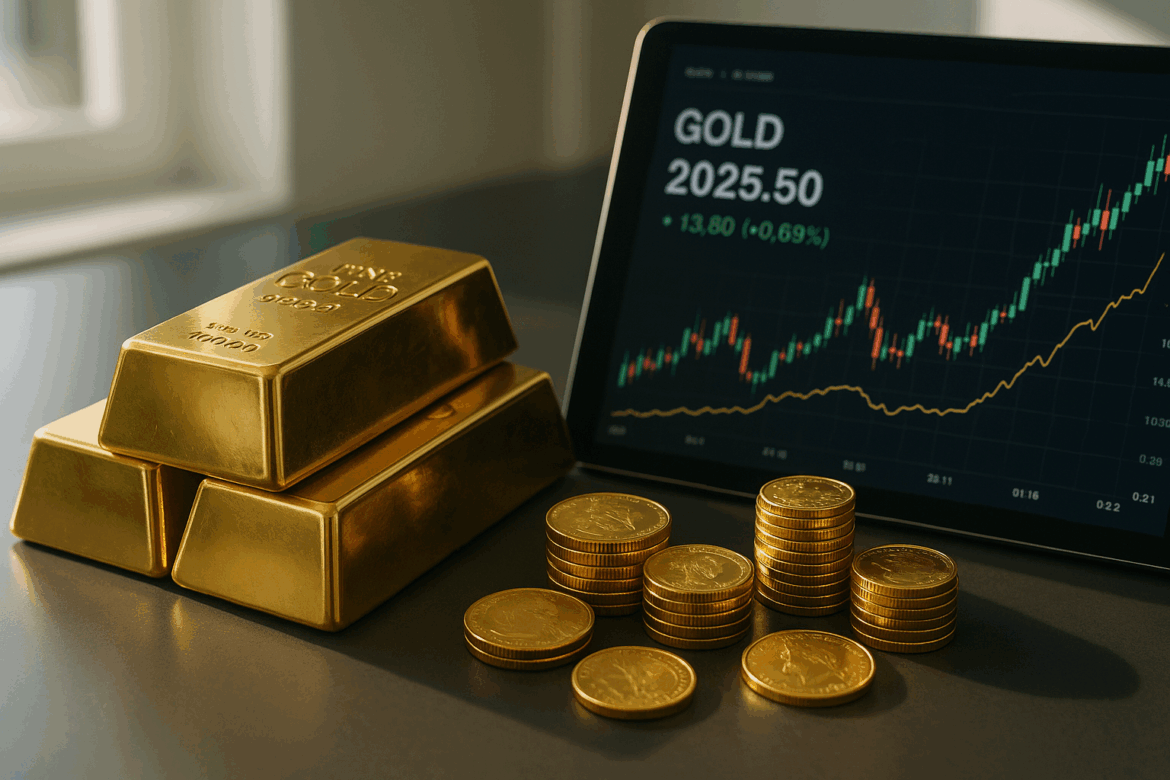Table of Contents
Introduction: Gold’s Timeless Allure
For thousands of years, gold has been the ultimate symbol of safety and wealth. Empires rose and fell, currencies collapsed, but gold endured.
Even in the 21st century — during recessions, wars, and market crashes — investors have turned to gold as a safe haven. But now, in 2025, the world looks different:
- Inflation remains stubbornly high.
- Central banks are testing digital currencies.
- Bitcoin and other digital assets are emerging as “digital gold.”
So, the question investors are asking is simple yet profound: Is gold still a safe haven in 2025?
Let’s explore the data, trends, and expert opinions shaping gold’s role in today’s financial world.
What Makes Gold a “Safe Haven”?
A safe haven asset is one that retains or increases in value during market stress. Gold qualifies because:
- It has intrinsic value (limited supply).
- It’s not tied to any government or currency.
- It performs well when stocks, bonds, or fiat currencies fall.
Historically, during recessions, wars, or inflationary periods, gold prices have surged.
Gold’s Performance in Recent Years
| Year | Average Price (USD/oz) | Key Events |
|---|---|---|
| 2020 | $1,770 | COVID-19 pandemic, global uncertainty |
| 2021 | $1,800 | Inflation fears rise |
| 2022 | $1,790 | Russia-Ukraine war, energy crisis |
| 2023 | $1,940 | Bank collapses, US debt ceiling debate |
| 2024 | $2,050 | Spot gold hits record highs |
| 2025 | $2,300+ | Central bank demand, weak global growth |
Gold prices hit all-time highs in early 2025, driven by:
- Persistent inflation
- Central bank buying (China, India, Turkey)
- Geopolitical instability in Europe and Asia
👉 Gold is proving resilient, but the story is evolving.
The Economic Backdrop of 2025
1. Inflation Remains Sticky
Despite aggressive rate hikes, inflation in the U.S. and Europe remains above 3%. Investors seek assets that protect purchasing power — gold tops the list.
2. Geopolitical Uncertainty
Conflicts in Eastern Europe and trade tensions in Asia continue to fuel demand for safe-haven assets.
3. Rising Government Debt
Global debt is at record levels. When faith in currencies weakens, gold strengthens.
4. Digital Competition
Bitcoin and tokenized gold assets offer new ways to hold “value.” The competition is fierce, but gold’s history and tangibility still appeal to traditional investors.
Central Banks Are Buying More Gold
According to the World Gold Council, central banks purchased over 1,000 tons of gold in 2024, the second-highest on record.
Why?
- To diversify reserves away from the U.S. dollar.
- To hedge against inflation and sanctions risk.
- To stabilize national currencies.
Countries like China, India, Turkey, and Singapore lead this buying spree — signaling institutional faith in gold as a long-term store of value.
Is Gold Still Beating Inflation?
Gold is traditionally seen as an inflation hedge — but it’s not always perfect.
- During high inflation + rising interest rates, gold can stagnate as bonds become more attractive.
- However, during inflation + economic slowdown, gold tends to outperform.
In 2025, with real interest rates still low and inflation sticky, gold’s inflation-hedging power remains strong.
Gold vs. Digital Assets (Bitcoin & Stablecoins)
Many investors now compare gold to Bitcoin — calling it “digital gold.”
| Feature | Gold | Bitcoin |
|---|---|---|
| Tangibility | Physical, centuries-old | Digital, blockchain-based |
| Volatility | Low–moderate | High |
| Accessibility | Requires storage/logistics | Instantly transferable |
| Correlation to Markets | Negative | Increasingly correlated |
| Regulation | Established | Still evolving |
While Bitcoin’s returns have outpaced gold in some years, its volatility keeps conservative investors loyal to gold.
👉 In 2025, Bitcoin complements gold, not replaces it.
Tokenized Gold — The New Hybrid
Tokenization brings gold to the blockchain. Examples include:
- PAX Gold (PAXG)
- Tether Gold (XAUT)
- AurusGold (AWG)
Each token represents real gold stored in vaults.
Benefits:
- Easy trading
- Instant settlement
- Fractional ownership
Tokenized gold is a bridge between traditional and digital finance — reinforcing gold’s relevance in a digital world.
Risks to Gold’s “Safe Haven” Status
- Interest Rate Increases – Higher yields make bonds more attractive.
- US Dollar Strength – A strong dollar often pressures gold prices.
- Speculative Trading – Gold ETFs and derivatives introduce volatility.
- Digital Substitutes – Younger investors favor Bitcoin or tokenized assets.
- Economic Recovery – When optimism returns, safe-haven demand fades.
Gold Price Forecasts (2025–2030)
| Source | 2025 Projection | 2030 Projection | Key Reason |
|---|---|---|---|
| World Gold Council | $2,300–$2,500 | $3,000+ | Sustained central bank buying |
| JP Morgan | $2,250 | $2,800 | Inflation hedge |
| Goldman Sachs | $2,400 | $3,100 | Weakening USD, geopolitical risk |
| UBS | $2,200 | $2,700 | Moderate growth, soft rates |
Most forecasts agree: gold is likely to remain stable or trend upward — not explosive growth, but consistent protection.
How to Invest in Gold in 2025
- Physical Gold – Coins, bars, jewelry (store securely).
- Gold ETFs – Easy, liquid exposure (e.g., SPDR Gold Shares – GLD).
- Mining Stocks – Leverage gold prices but carry higher risk.
- Tokenized Gold – Digital alternative backed by physical reserves.
- Gold Futures – For experienced traders (higher volatility).
Pro Tip: Diversify — mix traditional and digital gold exposure.
FAQs
1. Is gold still a good hedge against inflation?
Yes, especially in prolonged inflation with low real rates.
2. Should I buy gold or Bitcoin?
Both — gold for stability, Bitcoin for growth.
3. Is gold overpriced in 2025?
Not necessarily; prices reflect global uncertainty and demand.
4. Can gold prices crash?
Possible short-term dips, but long-term stability is strong.
5. Is tokenized gold safe?
If issued by regulated, fully-backed platforms — yes.
Outbound Links (Helpful Resources)
- World Gold Council – Market Updates
- Bloomberg – Gold Prices and Analysis
- IMF – Global Economic Outlook
Conclusion: Gold’s Safe Haven Legacy Lives On
In 2025, gold remains one of the most reliable hedges against uncertainty — but it’s evolving.
- Central banks continue to buy.
- Prices hover near record highs.
- Investors still trust its stability.
However, the definition of “safe haven” is expanding. Digital gold, tokenized assets, and Bitcoin ETFs are reshaping the landscape.
The answer to “Is gold still a safe haven in 2025?” is yes — but in a more competitive world. Gold remains timeless, trusted, and tangible, even as finance goes digital.

